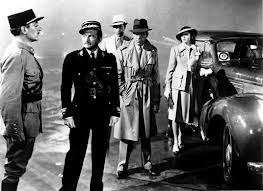.JPG) |
| The Jean Bart, foreground, and Richelieu, as depicted by A&A War at Sea |
One of the side effects of the Washington Naval treaties in the 1920s and 1930s was to introduce a discontinuity in capital ship design. With the exception of Britain's Nelson-class battleships, none of the multitude of post-World War I battleship/battlecruiser designs were realized as actual warships.
Instead the oldest of the World War I designs were generally scrapped and the battlelines of the major powers comprised the newest ships designed during the Great War -- which meant they didn't always take full advantage of the lessons of combat during that war.
Some navies modernized the older ships extensively, most modernized them somewhat and a few ships, like the HMS Hood, ended up missing out on scheduled modifications.
The key attribute of the Great War-era ships was that technology forced severe tradeoff between firepower, protection and speed. Different navies tended to make different judgements about the relative importance of the three attributes, but technology forced a choice to be made. The British and Americans tended to prize firepower and protection most of all and therefore their battle lines tended to be slow, with few battlecruisers in support providing a fast wing, albeit with less protection. The Japanese and Italians, in contrast, tended to value speed above all, and their ships tended to be somewhat lighter in protection than comparable Anglo-American designs. French dreadnoughts were generally not very well designed and didn't seem to have any particularly strong points.
As war clouds gathered in the 1930 and the various powers renounced the treaties or left them as they expired there was a new burst of battleship design. While some choices between firepower, protection and speed still had to be made, advances in naval technology had lessened the stark nature of those choices and it was possible to design battleships that were speedy, packed a punch and also had extensive protection.
Every major combatant naval power in World War II manged to have at least some of this new generation of battleships completed in time to see action, although all had their plans cut short to some degree by the outbreak of the war and the need to prioritize shipbuilding resources.
There were remarkable similarities between the designs, with at least navies (US, Italy, Japan) settling on a nine-gun, three-turret layout of heavy guns with speeds in excess of 28 knots. The other three major navies made some departures from that model. While speedy and well-protected the German Bismarck-class ships kept the conservative four twin-turret design of the late World War I classes. The German Scharnhorst-class battlecruisers went with the three triple turret design, but with lighter guns. The British and French tried layout involving quadruple turrets on their newest battleship classes, although weight problems eventually forced the British King George V-class ships to revert to a twin-gun design for the turret in the "B" position. But the A and C turrets were quadruple mounts, as were the two turrets in the French Strasbourg-class battlecruisers and the Richelieu-class battelships.
The motivation for the quadruple turrets, however, varied between the two designs. For the British, the quadruples were just a way to maintain the throw weight of the broadside when they decided not to go with triple-gun 16-inch turrets as originally designed. This design strategy ultimately failed, as it proved impossible to have three quadruple 14-inch guns and for a total of 12 rifles and instead the ships ended up with just 10. This didn't compare well with the nine 15-inch or 16-inch guns of other navies.
The design strategy behind the French quadruple mount was to make it possible to fire the ship's entire main battery over a wide range of angles by concentrating all 8 guns in two turrets. Every dreadnought design after the first few classes allowed a battleship to fire all its weapons in a broadside, but fore and aft ship could only fire somewhere between one quarter and one-half it guns. The French design allowed it to fire all its guns forward, although at the cost of allowing no fire to the rear. This was considered to be an acceptable tradeoff. The layout was tired on the Strasbourg-class battle cruisers and deemed a success to be repeated on the new class of battleships under construction as the war started.
As it turned out, only the Richelieu was finished before the French defeat, Both it, and its unfinished sister Jean Bart were sent to African ports and remained there under Vichy control. Richelieu was at Dakar in Senegal while Jean Bart was at Casablanca. Both were significant threats that the invasion plans had to take into consideration.
Jean Bart was moored at Casablanca, which was one of the invasion sites, but her power plant was incomplete and she therefore didn't have adequate mobility to either confront or escape from Allied naval forces in the open ocean. Jean Bart's armament was even less complete, and in fact it had just one of its two turrets mounted and none of its secondary battery of 6-inch guns. On the other hand, the one turret that was mounted was fully operational, including its fire control system. In effect, the Jean Bart was a shore battery.
Richelieu was fully operational, in contrast. Although located at Dakar, which was far from the invasion sites, its possible appearance at the invasion beaches has to be considered in the operational plans. In the actual event the Richelieu did not intervene and even ended up joining the Allies later in the war after being updated in an American shipyard. The Jean Bart was completed after the war.

.JPG)
.JPG)


